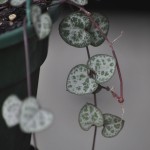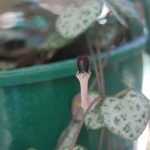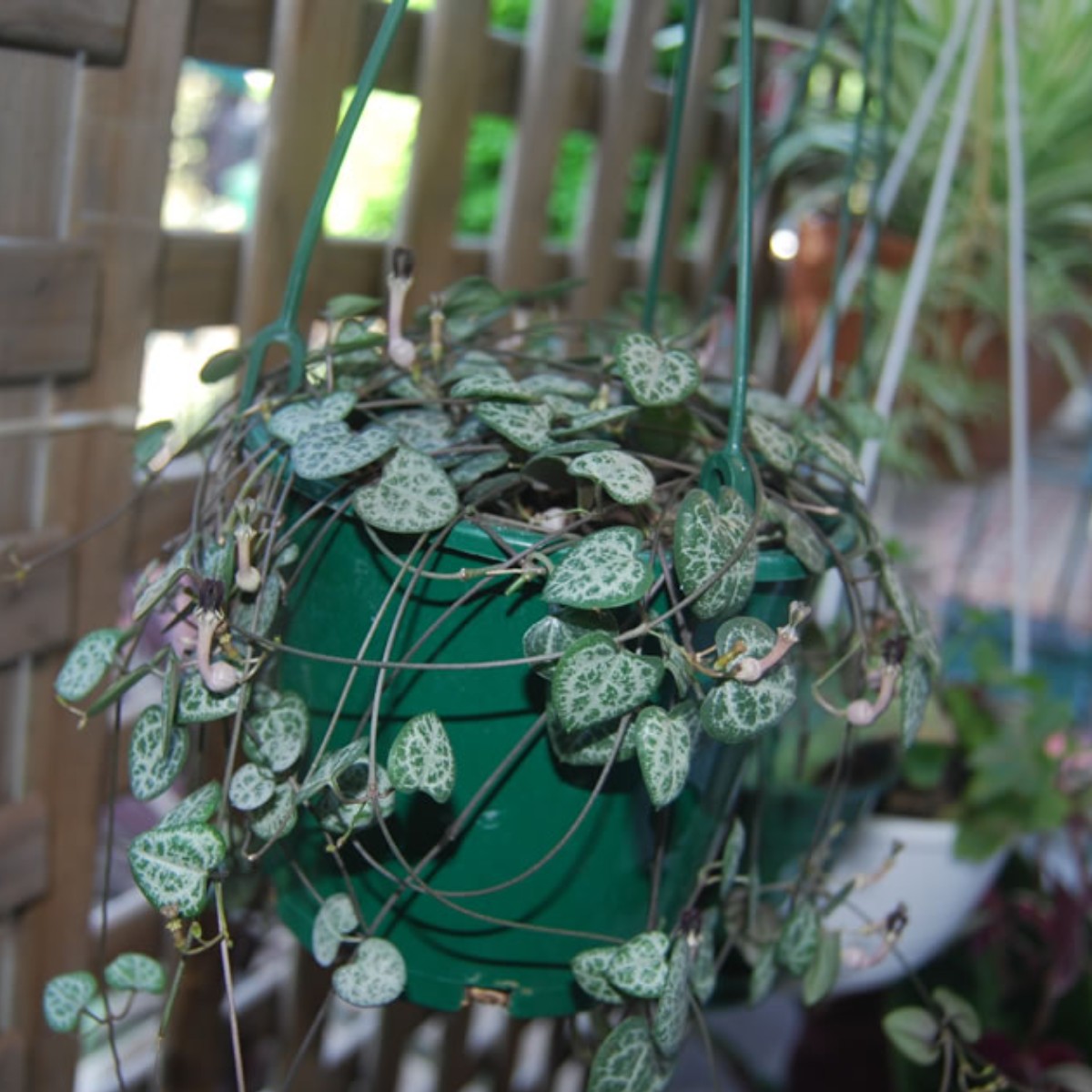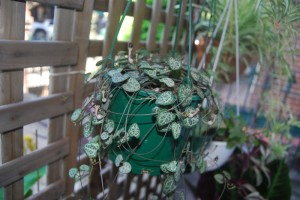Family: Apocynaceae
Synonymous: Ceropegia barbertonensis
Ceropegia collaricorona
Ceropegia euryacme
Ceropegia hastata
Ceropegia leptocarpa
Ceropegia linearis
Ceropegia schoenlandii
Distribution and habitat: Ceropegia woodii is native to South Africa, Swaziland, and Zimbabwe. It is an evergreen succulent trailing vine that grows to 10 centimetres (4 inch) in height and spreads to reach up to 24 metres (6.513 feet) in length. It lives in forested areas with its small tubers embedded on rocky ledges or in banks of soil. In its natural environment, root development is stimulated when the nodes touch the soil. The plant is thus easily grown from cuttings.
Description: Ceropegia woodii are trailing stemmed plants, pendent arising from a tuberous rootstock. Only Ceropegia woodii fromCeropegia species is popular as indoor plant, which is a highly effective trailer for use in a small hanging basket.
The tuberous base of Ceropegia woodii is quite hard, gray, woody and wrinkled and it can eventually measure as much as 5cm (2 inch) across. It usually sit on the surface of the potting mixture and from it emerge several purple, thread-like stems. These stems can grow 1m (3 feet) long, but do not generally exceed 45cm (18 inch).
Along stems, at about 8cm (3 inch) intervals, grow opposite pairs of fleshy, heart-shaped leaves on short leaf stalks. The delicate little leaves are dark green and marbled with silvery white on the upper surface and purple on the underside. From the leaf axils appear 2cm (0.7 inch) long flowers vertically oriented, each of which is a narrow, fresh-coloured tube housed in a small, round, purple base. The flowering season for Ceropegia woodii is usually late summer to early autumn. The flowers last up to six weeks.
Here and there along the stems of Ceropegia woodii, tuberous growths are produced and these are used for propagation. The flexible stems branch occasionally, usually at one of these small tubers.
The stem can grow free hanging down over the edge of the pot or basket, but alternatively the long stems can be trained upward on miniature trellises.
Houseplant care:
Light: Ceropegia woodii needs at least three or four hours of direct sunlight every day. Too little light impairs leaf colouration and extends the gaps between the pair of leaves.
Partial shading is useful when the plant is grown outdoors.
Temperature: Normal room temperatures are suitable for Ceropegia woodii throughout the year.
It can be grown outdoors only in subtropical and tropical areas, with a minimum temperature of 15C (59F).
Water: In the active growth period water sparingly, just enough to make the potting mixture barely moist, allowing the top two-thirds of the potting mixture to dry out between waterings. During winter, water very sparingly , just enough water to prevent the potting mixture from drying out completely.
Fertilising: During the active growth period give standard liquid fertiliser once a month, but only to fully mature healthy plants.
Potting and repotting: Use an equal-parts combination of soil-based potting mixture and coarse sand. Be sure to have a shallow layer of clay pot fragments in the bottom of pots for quick drainage. Move small plants into pots one size larger in spring; older plants will continue to thrive in 8cm (3inch) or 10cm (4 inch) pots or half pots for several years. When planting a few Ceropegia woodii in a single hanging basket, place the tubers about 4-5cm (1.5-2 inch) apart to get them the most effective display.
Propagation: At any time during the active growth period, Ceropegia woodii can be propagated by means of the tuberous growths produced along the stems. After removing a stem tuber, set it in a small pot of recommended potting mixture over which a centimetre (0.4 inch) or so of coarse sand has been sprinkled. Placing the tuber just on top of sand to prevent rot.
Alternatively, stem cuttings 15cm (6 inch) long may be used instead; they should be planted in same mixture, but some extra sand should be trickled down the hole made for the cutting as insurance against rotting.
The potted tuber (or cutting) should then be stood in medium light and watered very sparingly - allow about two-thirds of the potting mixture to dray out between applications - until the new feeding roots are established. New top growth will appear before these roots have been made; this may take around eight weeks, after which growth will be quite quick. When the young plant is established and growing well, move it gradually into a position where it will get direct sunlight. From this stage the plant can be treated as a mature Ceropegia woodii.
Problems: Ceropegia woodii is generally trouble-free.
Yellowing leaves may indicate rotting of the tuber, due either to over-watering or to winter temperatures that are too low.
Treatment: Remove soil from around the tuber and allow it to dry out if the damage is not too severe. Unfortunately, if the tuber has rotten the condition cannot be reversed and the plant will have to be discarded.
Ceropegia woodii has few pests, but mealybugs can be a problem.
Treatment: Treat any infestation immediately with an appropriate pesticide. Spray all top growth with pesticide. During the next month examine plants weekly for traces of re-infestation.
Uses: Ceropegia woodii is often grown in hanging baskets so the long trailing branches can hang down with their leaves spaced out like a row of long beads.
Ceropegia woodiimay be used as a focal plant to attract interest, because the flowers have a unique shape. It is ideal for hanging baskets that could be hung from tree branches or above a patio. Alternatively, consider potting the plant and training it to grow along a small, circular trellis to produce a decorative hoop of leaves. It will be attractive when hung against a wall like a curtain or from the top of a pergola. It is best used as a container plant under roofed patios, on verandas, balconies of flats or any other place in and around the house where space is restricted.
SUMMARY:
CHARACTERISTICS:
Foliage coloured
Features - flowers
Shape trailing
Height: 1m (3 feet)
PROPER CARE:
Watering in rest period sparingly
Watering in active growth period sparingly
Light direct
Temperature in rest period min 16C max 24C (61-75F)
Temperature in active growth period min 16C max 24C (61-75F)
Humidity low
Hardiness zone: 10 11





